"If the world had any ends," Aldous Huxley wrote in 1934, Belize - then known as British Honduras - "would certainly be one of them. It is not on the way from anywhere to anywhere else. It has no strategic value. It is all but uninhabited."
Almost 75 years later, Belize still feels remote. It's roughly the size of Massachusetts, yet it has only a handful of traffic lights. The two-lane road that spans the length of the country is not, in many places, paved. If Huxley were around to be a consumer of American pop culture, however, he'd find that Belize - or at least the strip of it that runs along the Caribbean Sea - has been discovered.
The Fox reality series Temptation Island taped its first season on Belize's Ambergris Caye. Francis Ford Coppola has opened resorts there. And there is a telling moment in Tara McCarthy's Wouldn't Miss It for the World, in which an ugly American stands at a tiki bar in Belize and yelps: "Panty rippers for everyone!" - referring to a cocktail that blends pineapple juice with coconut rum.
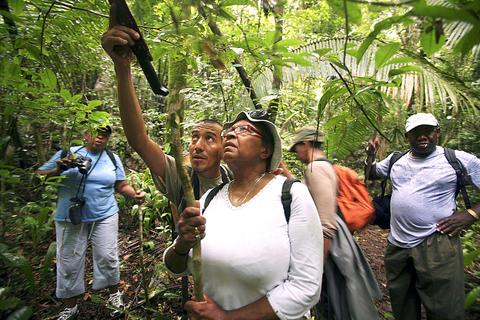
PHOTO: NY TIMES NEWS SERVICE
I underlined that passage and showed it to my wife, Cree. "Uh-oh," she said.
Belize's still largely untrampled beach areas are filling with tourists for good reason. The country has the largest continuous barrier reef in the Western Hemisphere, one that's lined with hundreds of beautiful small islands, or cayes. The scuba-diving and snorkeling are world-class.
But there is a different Belize that we - my wife and I and our 7- and 9-year-old children, Harriet and Penn - set out to find: its lush interior, thick with rain forests, Mayan ruins, tiny villages, intense wildlife and intricate cave systems that can be explored by floating on inner tubes while dodging bats.
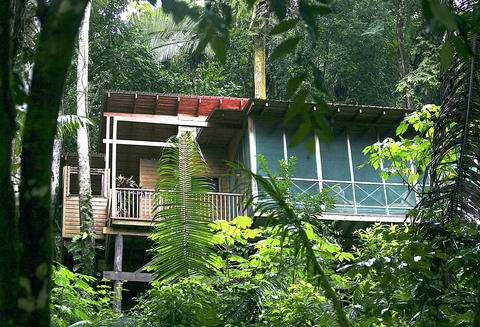
PHOTO: NY TIMES NEWS SERVICE
We weren't disappointed when we visited early in May. Moving through Belize's backcountry feels like travel, not tourism, and the country is fiercely intent on keeping it that way. National parks and nature preserves make up almost half of Belize's 14,000km2. You can truly become lost here, in ways both good and bad.
We land in Belize City on a hot morning, climb into a rental car - a battered black 2003 Mitsubishi Outlander - and head west toward our first destination, an eco and adventure lodge called Ian Anderson's Caves Branch. There is plenty to see along the way.
One observes immediately that there is real poverty in Belize. Leaving the airport, we drive past streets lined with shacks, shanties and small concrete houses; dead cars squatted on cinder blocks.
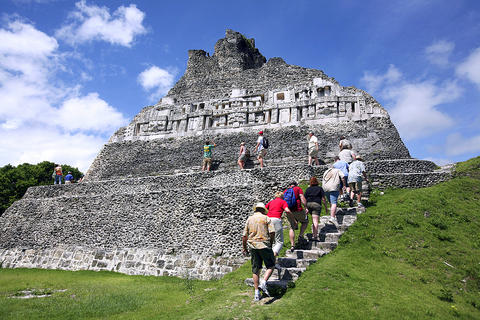
PHOTO: NY TIMES NEWS SERVICE
The poet Derek Walcott, a Nobel laureate born in St Lucia, is right to deplore the way outsiders view these kinds of scenes in the Caribbean: Photogenic poverty! Postcard sadnesses! But this makes them no less real and, at times, no less wrenching. Our children, staring from the window, are quieter than they have been in a long time.
Belize's population is fewer than 300,000 and, just a few kilometers outside of Belize City, we realize we're in the middle of nowhere, or very close to it. The landscape quickly becomes intensely green, freckled occasionally by dusty shacks and distant fires. Hit the search button on the car radio there, and the electronic numbers will race around and around until you put a stop to them.
Civilization, when it arrives on Belize's back roads, is in the form of "cool spots" - what Belizeans like to call their outdoor bars and restaurants, most with dirt or concrete floors. It's there, on a sweltering day in a friendly cool spot, where we are first struck by Belize's headache-making contradictions.
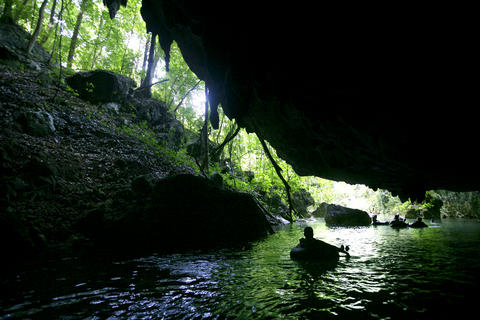
PHOTO: NY TIMES NEWS SERVICE
"Hey, OK, you want one of these?" the shirtless bartender asks. He is holding a small chilled bottle of Guinness Foreign Extra Stout - a Belizean favorite, it turns out, and known as "short, dark and lovelies." (Guinness? In the tropics?) This is not the only Anglicism we immediately encounter. Queen Elizabeth II stares from Belize's paper currency. English is its official language. And can that really be the name of the brand of cigarettes the men are smoking? Yes, it is: Colonial Lights.
Belize may be in Central America, tucked under the Yucatan Peninsula between Mexico to the north and Guatemala to the south and west, but it was a British colony for more than 100 years, fully achieving its independence only in 1981. The population here is a heady mix - you will hear Creole, Spanish and Garifuna spoken in this polyglot country - but more than a few traces of that colonial era survive, a fact that only adds to your sense that Belize has a mild to moderate case of cultural schizophrenia.
This condition plays out in Belize's native cuisine - or rather in its mystifying lack of one. Lunch at this cool spot is rice and beans (or rice 'n' beans in the Belizean pronunciation) along with stewed chicken, which is more or less the national dish, and one we'll be eating variations of for an entire week. It's a good thing the kids take to it immediately.
Fresh, local food is (the British are pretty much to blame here) hard to find in Belize. Its coast may stretch some 380km, but good luck finding fish that hasn't been frozen. Orange groves are everywhere, and giant trucks piled with oranges roar frighteningly past on the tiny roads. But we find only grim concentrate to drink for breakfast, or to mix with the local rum.
Trying to purchase local ingredients in Belize, in fact, can make you feel like you're making an illegal drug buy. This point is made, comically, in Richard Wilk's book Home Cooking in the Global Village, about Belize's food ways. "You have to know the right person," he writes. "You have to be patient; there is no rushing the process."
I quickly come to understand why Marie Sharp is a national hero. It's hard to image Belizean cuisine without a few shakes of her ubiquitous brand of carrot-and-habanero hot sauce, a small white bottle of which decorates nearly every restaurant table. It is the best hot sauce I've tasted; mellow, not palate killing, but flavorful and very much there. (If you take only one thing away from this article, make it this: order a bottle online.)
Ian Anderson's Caves Branch is a few hours' drive from Belize City, nestled along the lovely and aptly named Hummingbird Highway. We arrive in mid-afternoon, and our first impression is, frankly, not good. The place seems deserted. What's more, it's very hot, and because it is the dry season, the river that snakes through the lodge's property has vanished, leaving only a dusty, stone-filled riverbed.
Our need to cool off, and quickly, leads us to a miraculous discovery. A kilometer or so from the lodge, a pokey trail leads down to a small natural freshwater pool, or cenote, known as the Blue Hole. It is easily one of the most beautiful spots I've ever seen: a turquoise swimming hole fed by a cool underground river and surrounded by limestone cliffs and deep jungle. It is empty, and we spend a blissful hour splashing around alone.
Refreshed, we recognize Anderson's for the singular place it is. The warning posted on its Web site turns out to be accurate: "Ian Anderson's Caves Branch is neither a 'sightseeing' business nor a 'resort'! If you are looking for a jungle resort that is sanitized from its surroundings then we are not it."
Because Anderson is dedicated to adventurous and sustainable tourism, and because he hires first-class guides, the crowd he attracts is hardy, inquisitive, international and a lot of fun.
Meals are communal, and the rooms range from inexpensive huts to quite luxurious tree house suites, which are hillside rooms that have trees growing through the center. At our children's urging, we elect to stay in one of the latter; they want to be able to tell their friends they've slept in a tree. And, OK, so do we.
The options for exploring are numerous, the guides explain in the evening. There are jungle treks and trips to Mayan ruins, river kayaking survival expeditions, and rappelling and spelunking.
We opt for a floating cave tour and spend the next day on inner tubes, drifting in the dark cool water for what seems like kilometers with miner's lamps strapped to our foreheads. It's a surreal experience. Bats hang within reach overhead; the guides point out cave markings and large cave spiders. It is a memorable day, made more memorable by jumping (in our wet clothes and following a guide's lead) off an 8m cliff into a deep natural pool.
After a late-night talking, drinking rum drinks and playing cards with other guests, we realize that Belize's jungles are not good places to nurse a hangover. It's hard to sleep. The jungle noises commence well before sunrise, a combination of howler monkeys, frogs, toads, toucans and cicadas that, together, make a sound we've never heard before; their symphonic attack sounds screechingly close to some of the electronic feedback on Lou Reed's Metal Machine Music.
But since we're up early, we decide to go for a long hike, and that dry riverbed turns into a bonus. We use it for our improvised trail, and follow it into the jungle. There's remarkable wildlife, including giant king vultures, their red and yellow heads atop imposing white, black and gray body plumage. From a tree overhead, a playful howler monkey tosses a piece of hard fruit at us. We must restrain the kids from retaliating.
It's disappointing to have to leave Caves Branch after two days, but we are booked for two nights near Placencia, a popular beach town farther south at the end of a long, narrow peninsula. Placencia, it turns out, has a laid-back end-of-the-line Key West vibe. American country music spills from the bars, and beer is cheap and plentiful. Vendors hawk "You Better Belize It" T-shirts. Bootleg copies of week-old American movies are for sale in shop doorways.
We stay for two nights in a nearby town called Maya Beach, in an A-frame beach hut at a hotel called the Green Parrot. We take the opportunity to hire a guide and go snorkeling 8km out in the Caribbean around a small uninhabited caye.
In the clear water around the tiny atoll that looks disconcertingly like the popular island screen saver, we see nurse sharks, barracuda and squid while acquiring sunburns of the kind that make you sit carefully even weeks later. But we are as content, snorkeling, as the character in Denis Johnson's new novel, Tree of Smoke, who thinks to himself: "The experience came close to what the birds of the air must enjoy, drifting above a landscape, propelled by the action of their own limbs, actually flying."
For dinner one evening, we drop in at the Coppola family's Turtle Inn. It's a quiet, intensely lovely resort, and the food - fresh fish, finally! - is very good indeed. We're happy to see this place but also happy to leave it. It feels packed with would-be hipsters, at least one wearing sunglasses at night, hoping for a glimpse of Sofia Coppola and the chance to force a screenplay under her arm.
Sometimes your happiest memories of a trip are the homiest, and the most unexpected. On our final night in Belize, at the Machaca Hill Lodge, a new resort in the Toledo District near the border with Guatemala, we sit on the veranda, taking in the views and drinking fresh watermelon-juice cocktails. The sun is a red fireball in the distance, and we play board games from the resort's collection of old American games.
IF YOU GO
GETTING THERE
>> United, Continental, American Airlines and China Airlines offer connecting flights from Taipei to Belize City. Most itineraries require at least three stopovers and last between 21 and 38 hours.
>> If you plan to drive much beyond Belize City, you will probably want a tough vehicle with four-wheel drive. At the Belize City airport, vehicles are available from Avis, Budget, Hertz and many local companies like Crystal Auto Rental.
WHERE TO STAY
>> Going to Belize means flying into Belize City. You may want to travel to your final destination right away. If you do stay in Belize City, the Fort George area has terrific views of the busy port.
>> A slightly funky but still nice option is the Great House, a restored mansion a block from the water (13 Cork Street; 011-501-223-3400; www.greathousebelize.com). Double rooms start at US$150. The Radisson Fort George Hotel and Marina (2 Marine Parade; 888-201-1718; www.radisson.com/belizecitybz) also has decent rooms and a view of the harbor, starting at US$134.
>> An easy two-hour drive beyond Belize City is Ian Anderson's Caves Branch Adventure Co and Jungle Lodge (Hummingbird Highway, www.cavesbranch.com). It has a range of accommodations and prices, from tree house suites at US$195 a night to bunkhouses for just US$15. Meals are family style, a bargain at US$12 for breakfast or lunch. Dinner is US$18. The locally made Lighthouse beer is excellent.
>> If you're heading for the beach in Placencia, it's worth spending more to stay at the Turtle Inn. (011-501-824-4914; www.turtleinn.com). With 25 rooms ranging from US$355 for a garden-view cabana to US$2,000 for the Francis Ford Coppola Family Pavilion, this is a lovely place, though you may miss the gritty, hippie charm of Placencia itself.
>> Near Punta Gorda, in Belize's southern Toledo District, a lovely and remote option is the Machaca Hill Lodge (Big Hill Road; 011-501-722-0050; www.machacahill.com). It has 12 elegant cabanas on a hillside with sweeping views. For double occupancy, a room during peak season is US$210. A meal package, including breakfast, lunch, dinner and hors d'oeuvres, is US$60 a day for adults and US$30 for children.
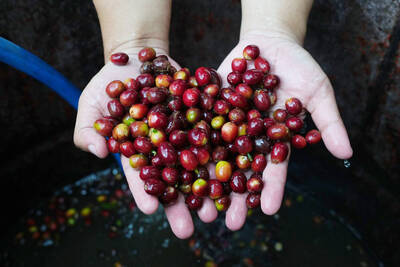
Climate change, political headwinds and diverging market dynamics around the world have pushed coffee prices to fresh records, jacking up the cost of your everyday brew or a barista’s signature macchiato. While the current hot streak may calm down in the coming months, experts and industry insiders expect volatility will remain the watchword, giving little visibility for producers — two-thirds of whom farm parcels of less than one hectare. METEORIC RISE The price of arabica beans listed in New York surged by 90 percent last year, smashing on Dec. 10 a record dating from 1977 — US$3.48 per pound. Robusta prices have

The resignation of Taiwan People’s Party (TPP) co-founder Ko Wen-je (柯文哲) as party chair on Jan. 1 has led to an interesting battle between two leading party figures, Huang Kuo-chang (黃國昌) and Tsai Pi-ru (蔡壁如). For years the party has been a one-man show, but with Ko being held incommunicado while on trial for corruption, the new chair’s leadership could be make or break for the young party. Not only are the two very different in style, their backgrounds are very different. Tsai is a co-founder of the TPP and has been with Ko from the very beginning. Huang has
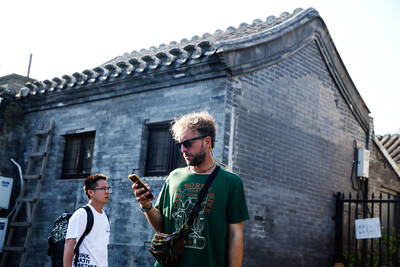
A few years ago, getting a visa to visit China was a “ball ache,” says Kate Murray. The Australian was going for a four-day trade show, but the visa required a formal invitation from the organizers and what felt like “a thousand forms.” “They wanted so many details about your life and personal life,” she tells the Guardian. “The paperwork was bonkers.” But were she to go back again now, Murray could just jump on the plane. Australians are among citizens of almost 40 countries for which China now waives visas for business, tourism or family visits for up to four weeks. It’s
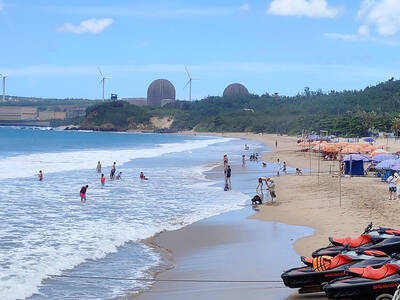
A dozen excited 10-year-olds are bouncing in their chairs. The small classroom’s walls are lined with racks of wetsuits and water equipment, and decorated with posters of turtles. But the students’ eyes are trained on their teacher, Tseng Ching-ming, describing the currents and sea conditions at nearby Banana Bay, where they’ll soon be going. “Today you have one mission: to take off your equipment and float in the water,” he says. Some of the kids grin, nervously. They don’t know it, but the students from Kenting-Eluan elementary school on Taiwan’s southernmost point, are rare among their peers and predecessors. Despite most of